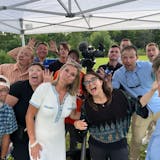One lovely summer day, Minnesotans hopped on their bright green rideshare bikes and set out to tour every Nice Ride station in the Twin Cities.
Just because it sounded like fun. Just because Nice Ride was there.
"It was just a great day," said Michael McKinney, who discovered the longest distance between two points that day in 2012. The dozen miles between the downtowns stretched into an all-day joyride by the time he and the other cyclists zig-zagged among all the stations in the fledgling rideshare system.
"I really appreciate having been a part of it," he said. "It was really fun, and it was a really unique way to see parts of the city."
The sturdy Nice Ride bikes were built for comfort, not speed, so it was a leisurely tour. From shady Summit Avenue in St. Paul, up and down the rolling banks of the Mississippi River, past the Mary Tyler Moore statue on Nicollet in Minneapolis, looping around and through all the neighborhoods, parks and side streets you never see until you look for them.
There were 145 Nice Ride stations in 2012. There were more the year after that, and the year after that. By last year, more than 400 stations popped up after the thaw, like the surest sign of spring.
But last year was the last year.
Unless new sponsors and funding can be found to replace what Nice Ride lost when Blue Cross withdrew its longstanding support, the rideshare that started it all has shared its last ride in the Twin Cities.



